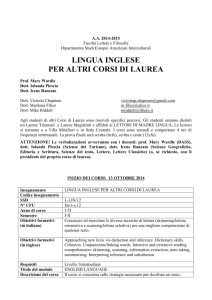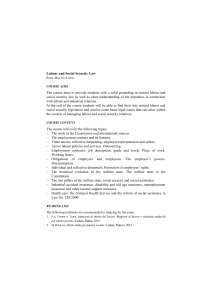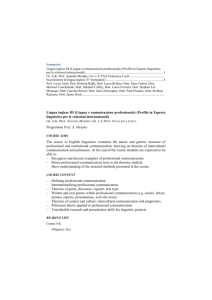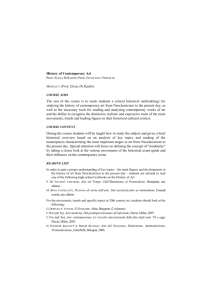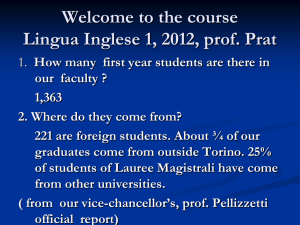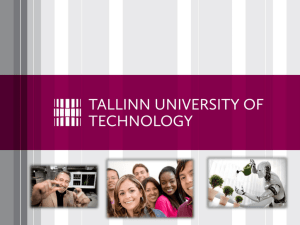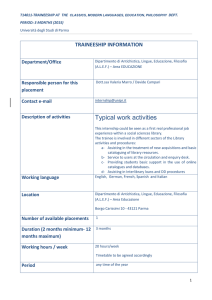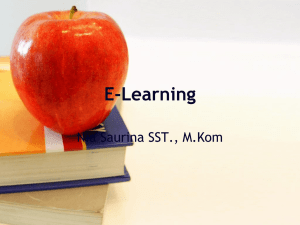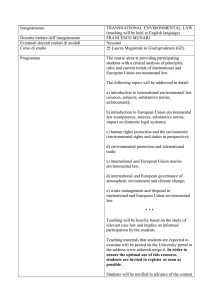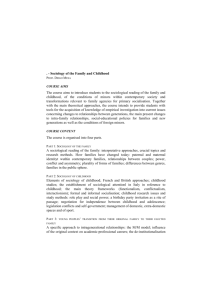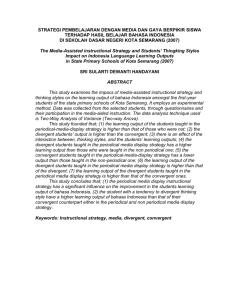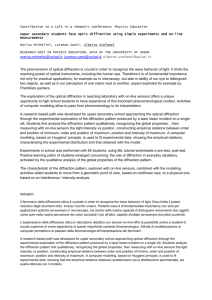Strategie comunicative e negoziali
advertisement
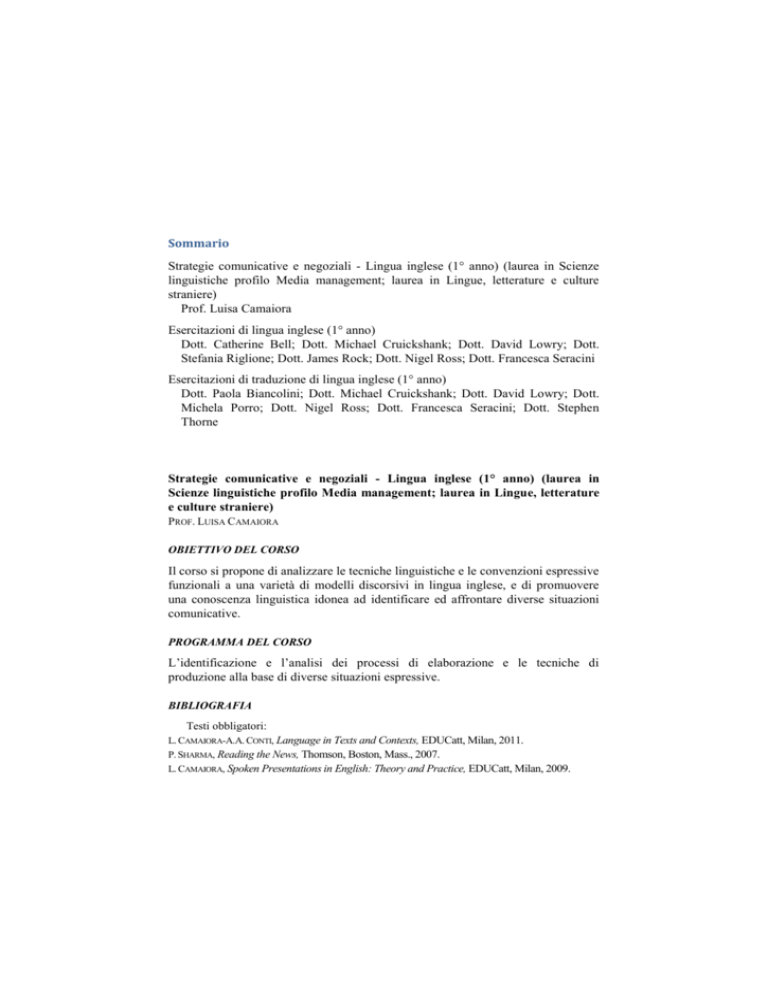
Sommario Strategie comunicative e negoziali - Lingua inglese (1° anno) (laurea in Scienze linguistiche profilo Media management; laurea in Lingue, letterature e culture straniere) Prof. Luisa Camaiora Esercitazioni di lingua inglese (1° anno) Dott. Catherine Bell; Dott. Michael Cruickshank; Dott. David Lowry; Dott. Stefania Riglione; Dott. James Rock; Dott. Nigel Ross; Dott. Francesca Seracini Esercitazioni di traduzione di lingua inglese (1° anno) Dott. Paola Biancolini; Dott. Michael Cruickshank; Dott. David Lowry; Dott. Michela Porro; Dott. Nigel Ross; Dott. Francesca Seracini; Dott. Stephen Thorne Strategie comunicative e negoziali - Lingua inglese (1° anno) (laurea in Scienze linguistiche profilo Media management; laurea in Lingue, letterature e culture straniere) PROF. LUISA CAMAIORA OBIETTIVO DEL CORSO Il corso si propone di analizzare le tecniche linguistiche e le convenzioni espressive funzionali a una varietà di modelli discorsivi in lingua inglese, e di promuovere una conoscenza linguistica idonea ad identificare ed affrontare diverse situazioni comunicative. PROGRAMMA DEL CORSO L’identificazione e l’analisi dei processi di elaborazione e le tecniche di produzione alla base di diverse situazioni espressive. BIBLIOGRAFIA Testi obbligatori: L. CAMAIORA-A.A. CONTI, Language in Texts and Contexts, EDUCatt, Milan, 2011. P. SHARMA, Reading the News, Thomson, Boston, Mass., 2007. L. CAMAIORA, Spoken Presentations in English: Theory and Practice, EDUCatt, Milan, 2009. Testi consigliati: N.D. TURTON-J.B. HEATON, Dictionary of Common Errors, Longman, Harlow, 1996. Essential Activator, Longman, Harlow, 2006. Dictionary of Contemporary English, Longman, Harlow, 2003. DIDATTICA DEL CORSO Lezioni in aula in lingua inglese e esercitazioni. METODO DI VALUTAZIONE Esame orale preceduto da una prova propedeutica scritta. AVVERTENZE Orario e luogo di ricevimento Il Prof. Luisa Camaiora riceve gli studenti come da orario affisso presso la Presidenza della Facoltà di Scienze linguistiche e letterature straniere. Esercitazioni di lingua inglese (1° anno) DOTT. CATHERINE BELL; DOTT. MICHAEL CRUICKSHANK; DOTT. DAVID LOWRY; DOTT. STEFANIA RIGLIONE; DOTT. JAMES ROCK; DOTT. NIGEL ROSS; DOTT. FRANCESCA SERACINI COURSE AIMS The aim of the course is to help students reach an advanced level in writing, reading, speaking and listening specific to their branch of study - English for Business and Management, Communication Studies, International Relations, Linguistics and Literary Studies, Tourism. Speaking and Listening Students are shown how to give clear, detailed descriptions and presentations on complex subjects. Attention is given to developing circumlocution strategies and encouraging students to qualify their opinions and statements. Practice is given in showing students how to adjust what they say and the means of expressing it to the recipient, and how to adopt a level of formality appropriate to the circumstances. Listening skills are improved as students are actively engaged in detailed discussion on general and complex topics both related to and beyond their field of study. At the end of the course, students are required to present a topic, using visual aids, and take an active part in simulated work situations, asking and answering questions, disagreeing and agreeing with other points of view, and summarising documents orally. Reading and Writing Specific attention is given to analysing a variety of both field-specific written genres, and to understanding some of the content-related conventions and techniques of written texts. Students are shown how to improve their ability to produce clearly intelligible continuous writing which follows standard layout and paragraphing conventions. Attention is also focused on encouraging students to express themselves in their writing with clarity and precision, using language flexibly, effectively and appropriately. At the end of the course, students are required to write on a domain-related topic, arguing for a particular point of view and making reference to two theme-related texts. COURSE CONTENT Oral Production Students are presented during the course with practical spoken exercises aimed at satisfying the course objectives. Attention is given to enhancing students’ command of spoken English in professional contexts. This will involve enabling them to plan and give professional presentations, lead and take part in work-based negotiations and meetings; improve telephone skills, engage in transactions, undertake problem-solving tasks, as well as to discuss current events at an advanced level. Written Production A variety of written material is presented and students are shown how to identify specific textual genres. Practice is given in producing different forms of writing and improving the ability to plan and write texts in professional contexts. READING LIST Reference Grammar R. CARTER-M. MCCARTHY, Cambridge Grammar of English, A comprehensive guide, CUP, Cambridge, 2006. Other bibliographical references will be made available during the course. TEACHING METHOD Lessons in class. ASSESSMENT METHOD Written exam The written exam consists in arguing for a particular point of view on the basis of two theme-related texts. The written text should be between 600/800 words. Students have three hours to complete the test. Monolingual and bilingual dictionaries may be used during the exam. Oral exam Students are given a selection of topics to prepare for twenty minutes on the day of the exam. They are normally asked to discuss two of the prepared topics. Students are evaluated on receptive, productive and interactive skills, and must prove their competence in pronunciation, fluency, grammatical accuracy and lexical appropriacy. NOTES Place and time of consultation hours The language teachers are available to answer questions after lessons. Esercitazioni di traduzione di lingua inglese (1° anno) DOTT. PAOLA BIANCOLINI; DOTT. MICHAEL CRUICKSHANK; DOTT. DAVID LOWRY; DOTT. MICHELA PORRO; DOTT. NIGEL ROSS; DOTT. FRANCESCA SERACINI; DOTT. STEPHEN THORNE COURSE AIMS The aim of the course is to develop translation competence by means of analysing and translating various types of texts in English and Italian. Particular attention is paid to identifying the characteristic linguistic and cultural aspects of various text types in English and Italian, so as to develop skills which are useful both for personal cultural development and for professional activities. Texts and translation tasks reflecting realistic simulations of work will thus be proposed. READING LIST B. OSIMO, Manuale del Traduttore, Hoepli, Milano, 2002. M. BAKER, In Other Words. A Coursebook on Translation, Routledge, London, 1992. Other bibliographic indications will be given out during the course. TEACHING METHOD Lessons in class. ASSESSMENT METHOD The final test of specialised translation is made up of one translation from English to Italian and one from Italian to English. The texts to be translated differ according to the students' specialisation areas and are of about 200 words each. Students have 3 hours to translated both texts and both monolingual (English and Italian) and bilingual dictionaries are allowed. NOTES Place and time of consultation hours The teachers are available to see students after lessons.
